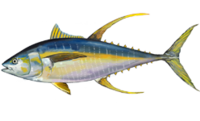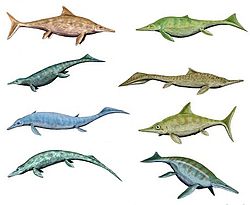
A dorsal fin is a fin on the back of most marine and freshwater vertebrates. Dorsal fins have evolved independently several times through convergent evolution adapting to marine environments, so the fins are not all homologous. They are found in most fish, in mammals such as whales, and in extinct ancient marine reptiles such as ichthyosaurs. Most have only one dorsal fin, but some have two or three.
Contents
Wildlife biologists often use the distinctive nicks and wear patterns which develop on the dorsal fins of whales to identify individuals in the field.
The bones or cartilages that support the dorsal fin in fish are called pterygiophores.













